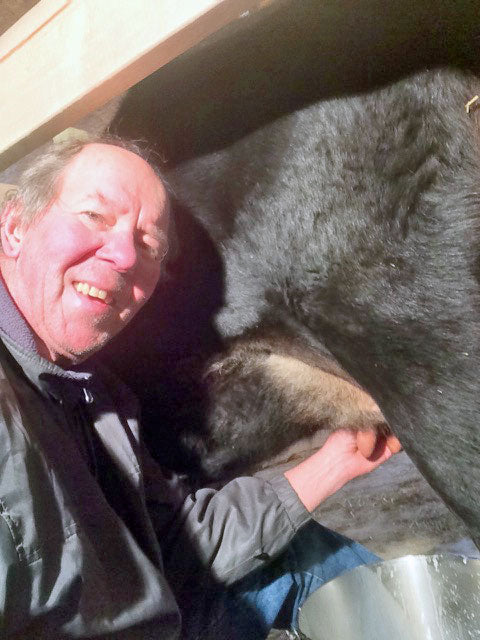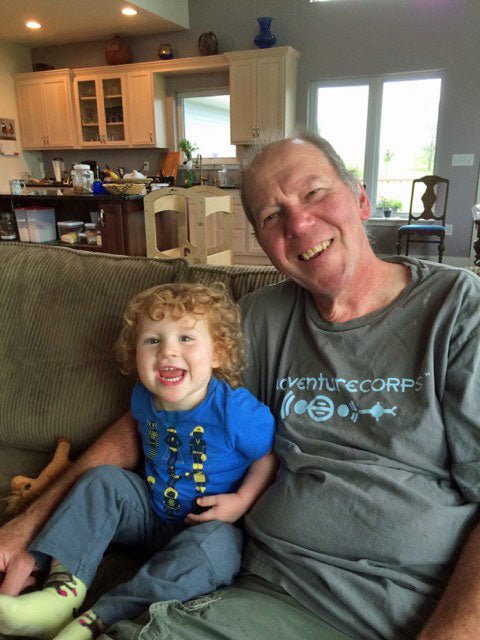
I recently added Jack Aldridge to my list of the most fun and interesting cheese makers in the entire world. I admit – this is a long list, but Jack is up there at the top. His energy and enthusiasm for life seemed to burst through his e-mails. He’s the kind of person who just makes you feel glad you’re alive.
At one point, in the middle of our interview, I mentioned that the American Cheese Society will be having it’s annual conference in Iowa next summer at the end of July. (I have to admit that because he’s retired, it never occurred to me that he might have other plans that week.) This was his response:
Ack! Why does everything interesting in Iowa happen the last week of July?? The annual Seed Savers Exchange camp out and conference is that weekend. (I am a listed SSE member, the only person in the United States preserving and distributing an heirloom, pole bean called, “Ura.”) The conference is great fun. Great group if you are an organic gardener and interested in crop diversity in the world today.
This is also the week of RAGBRAI, the (somewhat) famous annual Great Bicycle Ride Across Iowa, a week long, 480 mile biking/camping event, ridden by over 10.000 riders. I have done this for the last two years, since we moved to Iowa. I’m going to have to make some tough decisions on how to spend the last week in July this year!
Decisions, decisions. Retirement is exhausting!

Interview
When Jack first contacted us, I thought he was a marketer trying to place an “ad” in the “News From Our Customers” section of our Moos-Letter. He wrote:
I received an Anova sous vide heater/circulator for Christmas and find that it makes a wonderfully convenient, gentle heat source for the circulating water bath I am now using to cook and maintain my curds.
I use a very large canning kettle, with a quite large stainless steel pot to hold the milk/curds. The ability of the Anova to dial up and maintain a very precise temperature is simply a wonderful feature, and avoids the pitfalls of using direct heat on the stove or constantly adjusting sink water temperature with cold/hot water additions.
The attached photo shows the precision involved. Once things reach desired temperature, even a large volume of milk doesn’t need to be stirred to maintain a set temperature, due to the amount of surface area exposed to the swirling water around the pot.
The Anova unit costs about $179, so isn’t a huge investment.

I wanted to be sure he wasn’t selling this equipment, so I asked him for more information about himself. This became an interview and I added him to our “most amazing” category:
How did you get started making cheese?
We live on 67 acres of rolling prairie outside of Iowa City, Iowa. We recently acquired a family milking cow which is why I am now back into cheese making regularly.

The Oster electric skillet is Jack’s $25 dedicated cheese-wax melter.
My wife and I are retired small animal veterinarians, originally from NY/NJ. I worked for 36 years in San Francisco California at the San Francisco SPCA hospital.
I have always loved food, cooking, growing vegetables, making wine (which I’ve been doing since 1983) and anything involving above. I also have always loved cheese, a love which came to fruition when I lived for a year in central France, watching the next door neighbor milk and make goat cheese every day.

I think I first got into cheese making about 15 years ago, getting excited about the process after coming across Ricki’s books. In California, it is legal to sell certified raw milk, and for a while, I was able to obtain it in decent volume from a humanely operated organic farm called Organic Pastures. When they stopped delivering bulk milk to my area, I made a couple of trips to Fresno, California to obtain 10 gallon quantities, but the 2 plus hours each way became impractical. I wasn’t interested in making cheese from supermarket, pasteurized milk, so I halted my cheese production, after having managed to make a few decent cheddar type cheeses.

Those are 2 1/2 week old baby Swiss on the cheese board.
We moved (almost) full time to Iowa 3 years ago to be with my daughter on her country property outside of Iowa City, where we bought 67 acres of rolling prairie, planted two micro-vinyards, a huge organic vegetable garden and had a house built. After the joint families had acquired chickens, two llamas (to protect the chickens) and guinea fowl (who were all eaten by coyotes), we finally decided to take the plunge and obtain a family milking cow. My daughter bought a three year old dark brown Jersey and we’ve been milking her for the past two months.

Of course, this caused me, with great joy, to pull out my dusty cheese making supplies and start back to work. After tuning up with the usual fresh cheese suspects (cream cheese, queso blanco, queso fresco, ricottas etc.), I started with farmhouse cheddars, then your traditional cheddar recipes, baby Swiss, and provolones, so far.

In our new house, I had a cold room put in the half buried, walk out basement, well insulated. This room is fine for my wine and root vegetable storage, but only holds 55-63 degrees year round, so for now, I’ve obtained a used 1950’s GE refrigerator (that someone had converted to a kegger fridge, with convenient drilled holes for the fridge controller thermostat!)

I haven’t cut into any of my hard cheeses yet, as the oldest is only about 6 weeks old, but all seems to be going well. We get about 1 1/2 gallons of high butterfat milk each day with once daily milking. We will dry off Candy (the cow) the beginning of February, as she’s due in April, so I have a couple more weeks of cheese making before taking a respite.
Do you have any advice for folks who might be thinking about owning a cow or goat?
Although we were small animal veterinarians, in my day, at veterinary school, we had to spend at least as much time learning about dairy cows as we did about dogs and cats. Additionally, at Cornell University, I had to work for two full summers on a dairy farm in order to graduate. Although I found this exceptionally burdensome at the time, it turns out that the experience colored my life and taught me more valuable lessons than almost anything else I did. So, we did have some experience milking cows and caring for animals.
My only advice about getting milking animals, whether cows or goats, is to keep firmly in mind that this is a major commitment. Our cow only needs to be milked once daily for 10 months per year, but that is 7 days each week. There is lots of care: feeding, housing, watering (a small cow drinks 12 gallons of water each day, a definite chore in sub-freezing conditions!) Just like, “It takes a village to raise a child,” so too, “It takes a family to raise a family milk cow!”
I am retired, and after three years, and having read a couple hundred books, I was beginning to feel a bit indulgent and lazy. I needed a job, and milking a cow every day (my daughter spells me a day or two each week when she’s not working at her neurology residency) suits me just fine. But it does tie one down.
There are great resources on the Internet for family cow (and goat) people and I would advise extensive research along those lines before jumping in to acquiring a cow (or goats).
I’d be happy to answer any other questions, from you or any readers. If appropriate and desired, it is fine to give my email address if any of your readers want to ask any questions directly. (drjackthevet@yahoo.com)
Are you going to keep Candy’s calf?
Oh the calf question……a subject of great debate.
Candy is bred to a beef type, so, male or female, unless we want to keep her just for “pasture candy,” (as my daughter put it) it will either be sold or eaten. We are humanitarian-oriented meat eaters in this family, only eating verifiably humanely raised, free range animals, typically local now that we live in Iowa. However, there is great discussion about family member’s ability to eat a cow they have grown up with and know. We haven’t solved this issue yet. In years to come, we’ll likely breed her back to a smaller Jersey and then would likely keep a female for further reproduction, but that is a way down the road.
Pasture raised meat can be expensive, can’t it?
Yes, when we had to buy beef and other grass fed meat from the hot shot local coop, it costs up to 22 bucks per pound! Then I met a couple of local animal farmers who specialize in humanely raised, free range, organic chickens, lamb, pigs, and beef and life has been great since. The past two years we have purchased 1/2 beef (which yields a LOT of hamburger along with great steaks, by the way), a whole hog, and enough chickens to keep us for most of the year. I get to visit the animals to see how they are doing while being raised. It sure feels great to be a locavore in this regard. And the cost savings is very substantial, though you have to have a huge freezer.
Do you have any advice for new cheese makers?
For new cheese makers, it’s hard to give advice over and above the great tips available from your book and web site, except to emphasize that in the beginning, attention to detail and rigorous note-taking will really help. Along the way, however, people should look, touch and feel things, so that eventually, they can make decisions based on what is actually happening to their milk, cultures and conditions. It’s a bit like bread-baking. After enough successful (and failed) loaves, one can get a “feel,” for dough, and then go ahead and make a great loaf of bread without a recipe or measurements at all. (I recently used a batch of kefir that I decided I didn’t want to drink as a sourdough starter, mixing in some whole wheat, white and rye flower to make a sponge. It expanded over two days into a very tasty loaf and all made by feel and experience. I hope to someday get that way with my favorite cheeses.)

Did you get the sous vide specifically for cheese making?
No, I had a sous vide unit on my “wish list,” for Christmas, for cooking purposes and my son-in-law gifted this one to me. I immediately realized the possibilities for using the unit for steady water bath temperature control and was pleased with the experiment. I’ve yet to make a sous vide dish (!) but plan to soon.

What is a sous vide dish?
So, sous vide is an interesting method of cooking many things easily and somewhat differently than traditional. I haven’t tried chicken yet but that is supposedly amazing. You pack up your pieces in vacuum bags, (if you have them) or heavy ziplocks with seasonings if desired, and then you “poach” the meats in the circulating water bath for as long as it takes to 1) get the product to temperature (and it won’t overcook) and 2) get to the tenderness you desire. The second is the key. You can cook chicken to a perfect doneness but with some extended time, it gets tender and retains lots of juice and timing isn’t critical. Typically, meats are then slipped out of the packages and quickly browned, either with a broiler, very hot fry pan on a stove, griddle, etc. It only takes a few seconds or minutes to put a nice brown or char on a piece of meat and the insides are left cooked to the exact degree you wish, through and through. You probably know this all, but the point is, the tenderness that can be achieved, with limited cooking skill involved, is interesting.
My son in law did carrots the other day, and he said they were great, concentrated carrot flavor and nicely tender. My daughter made a custard for ice cream (if you’ve ever scrambled eggs trying to make a delicate custard, you can appreciate the ability to dial up the perfect temperature and then not worry about over cooking the mixture). I made a sous vide rhubarb dessert that was an eye-opener, with intact pieces of rhubarb, no strings, but spoon tender. etc., etc.
But, it’s definitely a hobby luxury silly thing for the home cook. Restaurants love the systems as they can have portions prepared well in advance, as the products will hold for hours sometimes without changing much.

With his grand-daughter, Jadzia














































































































































